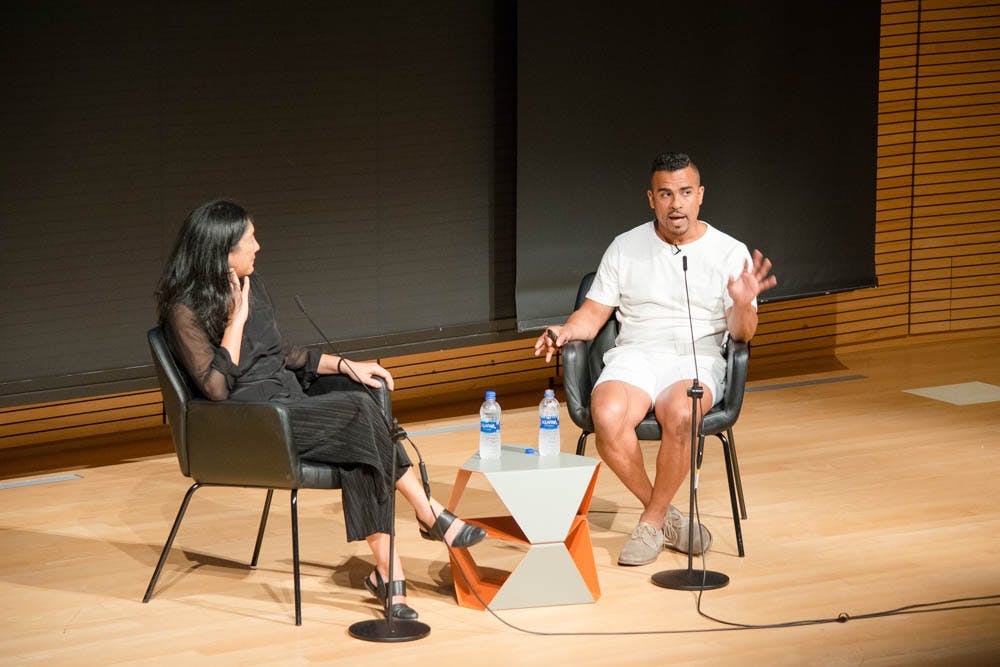Multidisciplinary artist Shaun Leonardo and Christina Yang, director of public programs at the Solomon R. Guggenheim Museum in New York, drew a crowd of students and faculty to the Martinos Auditorium in the Granoff Center for the Creative Arts last night for a conversation about Leonardo’s work and his recent performance at the museum.
Heather Bhandari, adjunct professor of visual arts, introduced Leonardo “as an exceptional artist, a social activist and an extraordinary educator,” as well as “a powerful disrupter and change agent.”
Leonardo is based in Brooklyn, New York. He received his Master of Fine Arts from the San Francisco Art Institute and has received support from Creative Capital and the Guggenheim Social Practice initiative. As a testament to his dedication to social practice, Leonardo co-founded Assembly, a program that invites youth aged 16 to 24 who have been arrested to join Leonardo in a storytelling and performance workshop as an alternative to having their cases pursued in court.
“Shaun and I are excited to present a view of what it takes to sustain a social practice within the life of an artist and also within the confines of a museum,” Yang said. “These are particularly divisive times in the United States, and Shaun is a unique artist working across many worlds, encompassing the visual arts, masculinity, performance, black and brown identities, failure and the law,” she added.
Leonardo began by giving an overview of “Primitive Games,” the piece he recently exhibited at the Guggenheim. The piece involved the coalescing of four distinct groups: members of the New York Police Department, military veterans, recreational users of firearms and citizens impacted by street violence. After four months of negotiations and workshops, the groups came together in the Guggenheim’s rotunda — which had been transformed into a gladiatorial arena — to debate through voiceless movement.
The groups were not privy to the identities of the other groups at any point throughout the workshops and were not made aware of the central issue of debate until the performance. “They could not perceive who was on the other side of that argument until they were faced with that person,” Leonardo said. This avoided the creation of talking points, which often cause communication to fail before it has been initiated, he added.
“The argument that I’m posing here is that what interrupts or completely defeats interconnectivity is the fact that language is the very thing that gets in the way,” Leonardo said. The performance removed the possibility for the groups to fall back on defensive language, he explained, forcing them to rely on the embedded choreography unique to each identity.
To transport a slice of the exhibit, Leonardo asked the Granoff audience to stand and participate in an exercise used in “Primitive Games.” Posing questions such as “Do you think you will be alive in ten years?” and “Have you ever held a bullet?,” he asked each audience member to respond by rotating their body a quarter-turn in either direction. The audience shifted, with people ending up in opposition, isolated or facing one another, depending on each person’s private responses. At the Guggenheim performance, this exercise was used to break the individuals of the four groups into two sides — revealing connections across group identities.
This was only a taste of the exercises that Leonardo introduced to students in a workshop held earlier Wednesday, which asked students to investigate whether debate could be played out through movement — like it had in “Primitive Games.”
Leonardo focuses on embodiment — taking on roles, characters, emotions — in many of his works. To do this, he has trained and become a “Mexican wrestler, a boxer, a mixed martial artist, a bullfighter,” he said. “So it was always important to me that in this embodiment … I was critiquing from the inside, out.” He began to involve other players in his performance pieces over time, moving away from a focus on the self, as he investigated masculinity, violence and community. One piece — “Bull in the Ring” — enacted a now-banned football drill of the same name, which required one player to enter a circle formed by his teammates and play the part of a matador, as another charged toward him like the bull.
“I’m consistently — and particularly these days — trying to find approaches and strategies for moving individuals and communities closer together,” Leonardo said, speaking to his work as an artist and a social activist.
As program director at the Guggenheim, Yang facilitated the realization of Leonardo’s work in the museum, “where it not only held the space, but … imbued the institution with risk-taking, vulnerability and strength in a way that transformed our conception of what kinds of conversations could happen within the often conventional walls of a museum,” Bhandari said.





